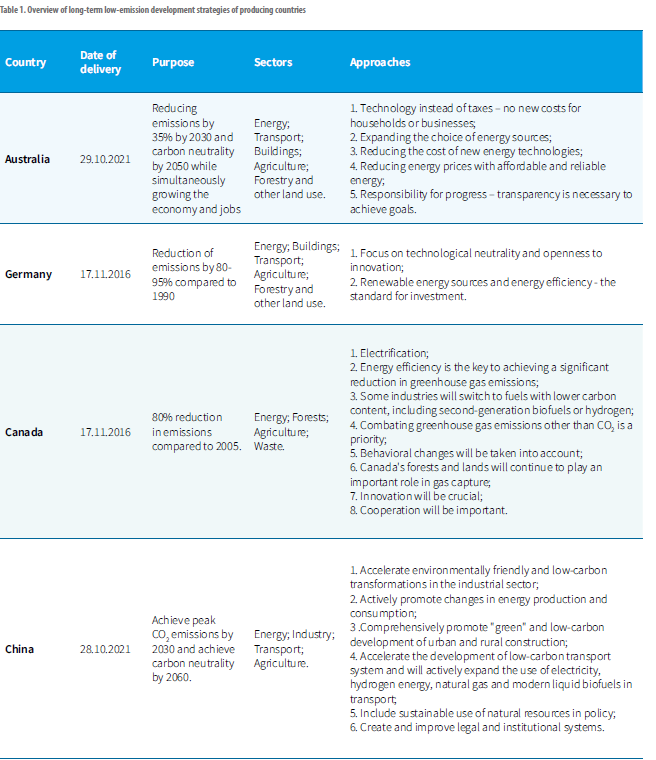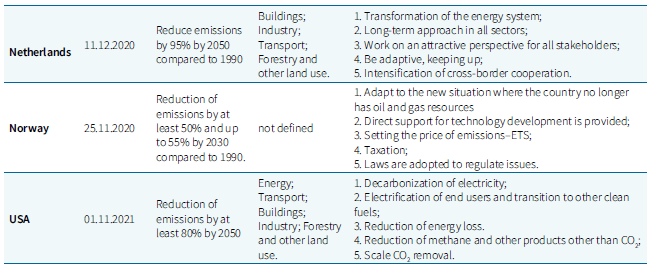Expert opinion09.09.2022
Kazakhstan's prospects for achieving carbon neutrality

B.K. YESSEKINA, Member of the Green Economy Council under the President of the Republic of Kazakhstan, Director of the scientific and educational center "Green Academy", Doctor of Economics, Professor
The pace of the global energy transition, as well as the implementation of the Paris Agreement aimed at keeping the temperature change no higher than 1.5 °C, has slowed down due to the changed geopolitical situation. At the same time, the decisions of the UNFCCC Bonn Conference1 held in June this year, as well as the EU Environment Ministers' Conference2, demonstrated commitment to climate policy and readiness to implement COP-26 measures (Glasgow Pact).
An example of decisive action and global cooperation in the field of adaptation to climate change was launched at the platform in Glasgow, the so-called coalition of pioneers that unites companies with supply chains in carbon-intensive sectors3. It includes representatives of large consumer goods and transportation companies, as well as companies engaged in renewable energy sources and using steel for construction of wind turbines. Currently, the Coalition unites more than 50 companies from nine countries (Denmark, India, Italy, Japan, Norway, Singapore, Sweden, the United Kingdom and the USA), which account for more than 40% of global GDP and 30% of global emissions. Companies with a combined market value of more than $8.5 trillion on five continents have demonstrated their willingness to commercialize new environmentally friendly technologies by committing to zero-carbon technology purchases by 2030 in six sectors: carbon dioxide removal; aluminum; aviation; shipping; cargo transportation; steel.
Many countries, including those in the top 10 world leaders in hydrocarbon production, are making efforts to justify new ways to decarbonize their economies by developing and updating national strategies and plans for their implementation (Table 1).
For example, China plans to achieve carbon neutrality by 2060 by accelerating the development of renewable energy, strengthening control over energy consumption, green transformation of industry, urban construction, transport, agriculture and regions. According to the country strategy presented in October 2021, the country plans to reach a peak in carbon dioxide emissions by 2030 and then begin the transition to carbon neutrality.


The European Union countries, which were among the first to present Low-Carbon Development Strategies (20162021) to the UNFCCC, despite rising prices for traditional energy carriers, are gradually tightening national emission reduction obligations (NDC) and requirements for importers of carbon products. As is commonly known, the list of goods subject to the border carbon tax (CBAM), starting from 2023, includes products of ferrous and non-ferrous metallurgy, chemical industry, building materials and other industries with a large carbon footprint. From 2026, it is planned to supplement this list with products of oil and gas and petrochemical industries, which makes the exports of producing countries vulnerable, including Kazakhstan.
In addition to tightening previously adopted national commitments in the field of emissions reduction -Fitfor55 , EU countries supplement national strategies with regulations.
For example, Germany was one of the first to present a Strategy for low-carbon development until 2050 and adopted the federal Law on Climate Change. The country is choosing the path of restructuring the energy sector, plans to further expand renewable energy sources and gradually abandon the production of electricity from fossil fuels, which will reduce emissions in the energy sector by 60-62% by 2030 compared to 1990. The Strategy Implementation Plan, within the framework of the Paris commitments, will be updated according to the adopted Law every 5 years.
The decarbonization plan of the Norwegian economy provides for support for low-carbon technologies, an increase in the emissions tax (from $95 to $240 per ton), the transition to zero-emission transport from 2022 (city buses from 2025) and other regu latory measures. The country has also adopted a Law on climate change (2018).
The prospects for low-carbon development in France are reflected in the National Strategy for Reducing Carbon Emissions and the Long-term Energy Program, which are based mainly on the transition from nuclear energy to renewable energy, technology development, etc.
In general, the EU countries consistently continue the policy of decarbonization of their economies. This, in this May, a new EU energy transition plan was adopted - REPowerEU , aimed at accelerating the transition to clean energy sources and reducing Europe's dependence on Russian energy resources. This plan is supposed to be implemented by solving the following tasks: 1) energy saving at all levels from households to industrial enterprises; 2) diversification of energy supplies; 3) rapid replacement of fossil fuels with renewable energy; 4) reasonable combination of investments and reforms.
The USA and Canada are also characterized by the continuation of the policy of achieving carbon neutrality and the adoption of legislation in the field of climate policy. The United States presented a Strategy in November 2021, the main priorities of which are: 1)Decarbonization of electricity; 2) Electrification of end users and the transition to other clean fuels; 3) Reduction of methane and other products other than CO2.
In the Strategies of Canada and Russia, energy efficiency, adaptation to climate change through improved forest and land use, technology and innovation are identified as priorities for the transition to low-carbon development.
For the Republic of Kazakhstan, which has ratified the Paris Agreement and submitted national commitments in the field of greenhouse gas emissions (in the amount of 15¬25% compared to the level of 1990 by 2030, UNFCCC, 2016), the task of achieving carbon neutrality by 2060, set by the President of the Republic of Kazakhstan K.Tokayev, remains very ambitious and requires a balanced climate policy.
According to the Statistics Bureau of ASPR RK, most of the greenhouse gas emissions (77.1%) are accounted for by energy activities related to the extraction, processing, transportation, storage and combustion of fuel (Fig.1). In this regard, it is these sectors that should become the object of close study and research by scientists, practitioners and politicians.
As the discussions within the framework of the Coal Forum recently held by the AGMP have shown, the collectives of coal industry enterprises, mines and branch research institutes are in urgent need of both studying, researching effective international experience in decarbonization of coal deposits, and developing special programs for technological modernization of production. Equipment wear is of great concern to miners: at some enterprises it reaches 80-85%, which causes an increase in the energy intensity of production and, accordingly, an increase in greenhouse gas emissions.
According to preliminary data of the Ministry of Energy of the Republic of Kazakhstan, the rejection of coal and other measures to decarbonize the economy can lead to the release of 27 thousand workers in the field of coal mining and energy production, and taking into account workers in other related fields - about 35 thousand. In this regard, this category of workers, the most vulnerable and at risk of losing their jobs in the process of energy transformation, should be covered by social protection measures, retraining programs, and provided with new jobs in low-emission industries. For this category of persons, it is necessary to develop programs offering alternative employment and retraining in order to carry out activities in new "green"
areas.
Regarding the reduction of carbon intensity in other extractive sectors of the economy, in particular, in the oil and gas and petrochemical industries, it is necessary to continue the policy of decarbonization by increasing the share of RES, improving energy efficiency through the introduction of the best available technologies (BAT), the development and implementation of carbon capture and storage technologies (CCS), especially during the transportation of raw materials. Despite the development of corporate strategies for low-carbon development, in a number of companies in this sector (KMG, NCOC, SHELLand others), which are certainly progress towards achieving carbon neutrality, a number of such areas as conducting independent technical, technological, energy audits to identify the carbon footprint and "leaks" of CO2, the introduction of digital monitoring for emissions remain out of sight of the environmental management of enterprises.
Of course, systemic issues of decarbonization of the energy sector and, in general, the country's extractive enterprises, such as the promotion and introduction of hybrid, maneuverable renewable energy, applied research in the field of hydrogen and nuclear energy, BAT, CCS and the introduction of carbon management standards and other measures, should receive support from the government within the framework of the currently being developed Strategy for achieving carbon neutrality until 2060.
The basic element of this strategic document, taking into account the above international experience and the specifics of the national economy, should be the improvement of the carbon regulation system that stimulates decarbonization. An analysis of the current situation shows that the current system of carbon regulation in Kazakhstan does not allow the country to achieve its commitments to reduce greenhouse gas emissions and needs to be radically improved.
Emissions trading also does not have the proper stimulating effect. According to the data of the Kazakh company CCE (CaspyCommodityExchange), which carries out emissions trading, in 2021 the cost of carbon units at the auction was at the level of 1-1.2 US dollars, while in the EU the price of carbon is over 70 dollars per ton of CO2. The updated NDC project (the contribution of the Republic of Kazakhstan determined at the national level for 2021-2025), developed by the MEGNR within the framework of the commitments of the Paris Agreement, assumes an increase in the price of a carbon unit to 16.9 US dollars in 2023-2025 and to 50.8 US dollars in 2026-2030. To achieve such a price for greenhouse gas emissions, it is necessary to take urgent measures to improve the efficiency of the carbon regulation system, stimulate emission reduction and the introduction of green technologies.
To achieve this goal in our country, according to research by McKinsey, it is necessary to increase the share of investments in decarbonization to 15% of GDP against 7.5% of the global average.
To solve these problems, we consider it appropriate to take the following actions at the national level:
1. Climate goals should be legally documented in legislative act. It is important to have an ambitious and stable long-term political environment. Among the world's 10 largest sources of greenhouse gas emissions, Japan, Canada, EU countries and South Korea have legally binding targets. Given the increasingly unstable political climate marked by the rise of populism, climate change efforts should not be held hostage to changing political priorities. The consolidation of the country's climate goals in the strategies, plans and programs of central and local government agencies and national companies to be implemented at the sectoral and local levels can ensure stability and certainty, contributing to the sustainable progress of the country.
2. Energy security planning should move from just-in-time planning to just-in-case planning, which requires maintaining sufficient reserve capacity and storage infrastructure using market mechanisms to encourage investment in these solutions. Additional benefits and a role in the field of energy security should be played by energy efficiency and energy conservation. Transparent and consistent dissemination of information, restoration of energy supervision institutions and the development of measures that take into account the distribution of responsibility between consumer groups can help stimulate public participation in improving energy efficiency.
3. Reducing the risk of investments in clean energy is essential to maintain capital inflows. Over the past decade, investment in the country's energy transition has increased, but this surge in investment came during a decade of economic growth and was partly driven by stimulating monetary policy and low benchmark interest rates. To date, the funding gap remains significant, so reducing the risk of energy investments is crucial.
4. The issues of equality and justice should occupy a central place in the energy transition. In recent decades, due to the relative inelasticity of energy demand, high energy prices have contributed to a high level of consumer price inflation. First of all, vulnerable segments of the population and small businesses suffer from this, which highlights the problems of equality and justice in the transition to new energy. Maintaining energy availability is very important not only for economic growth and social well-being, but also for supporting climate change policies. In this regard, it is necessary to take long-term systemic solutions to ensure equal access for vulnerable groups and small businesses.
In general, the decarbonization process at the country level requires systematic work and the adoption of appropriate investment, regulatory and institutional reforms both in the field of public administration and in the field of planning the development of the national economy and its basic industries. Due to the intersectoral nature of measures to achieve carbon neutrality, the importance for ensuring the energy security of the country in the subregion, there is an urgent need to create a coordinating structure under the President of the Republic of Kazakhstan in the form of the Agency for Alternative Energy and Climate with the support of the United Nations.
In this regard, the government, scientists, experts, and the business community need to understand that the decisions that will be incorporated into the Strategy today will determine the prospects for sustainable development not only of Kazakhstan, but also of the entire Eurasian region in the future.
Thus, the RK Strategy of achieving carbon neutrality until 2060, which is essentially a strategy for economic diversification and its technological breakthrough, should become a new long-term strategic document in the period of updating the socio-economic policy of the country.
Kazakhstan and UAE reaffirm strategic energy partnership with 1 GW wind project
Solar becomes EU’s top power source for the first time ever
How decentralised renewables transform healthcare services in rural Zimbabwe
Chinese company to build solar and wind power plants in Kyrgyzstan
Seaturns raises €2.45 million to industrialize wave energy technology and accelerate global rollout
Trump signs executive order to end subsidies for wind and solar energy
Uzbekistan's solar and wind power plants generate 5 Billion kWh since beginning of the year
Green Corridor Alliance JV registered in Baku to promote green energy development in Central Asia and the South Caucasus
In the EU renewable energy supply grew by 3.4% in 2024
IRENA accepting renewable energy project proposals in Central Asia until August 15
Astana to host Electronica Expo Kazakhstan Electronics Exhibition
WB gives rundown of Azerbaijan's green energy grid volume prospects
US solar sets new records as renewables nearly match natural gas – EIA
‘Wings’ on poles: Bill Gates-backed breakthrough wind turbine facility breaks ground
Perovskite tandem solar cell achieves new efficiency record
Kazakhstan and China endorse draft SCO joint statement on sustainable energy development
Innovative research on organic solar cells for space applications
Kazakhstan and Uzbekistan drive green energy progress in Central Asia
KazMunayGas launches pilot green hydrogen project in Atyrau
How private homeowners in Kazakhstan can make money from solar panels











